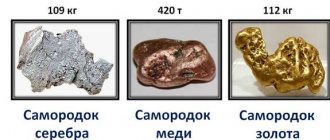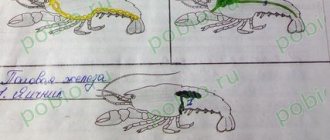Presentation “Structure and functions of the spinal cord” presentation for a biology lesson (8th grade) on the topic
Slide 1
Structure and functions of the spinal cord
Slide 2
The spinal cord is located in the spinal canal and in adults it is a long (45 cm in men and 41-42 cm in women) cylindrical cord, weighing 34-38 g and about 1 cm in diameter. The spinal cord begins at the level of the foramen magnum of the skull and ends conical pointed, at the level of the 2nd lumbar vertebra. The spinal cord is much shorter than the spine and because of this, the nerve roots extending from the spinal cord form a thick bundle, which is called the “cauda equina.”
Slide 3
Structure: Five sections: cervical, thoracic, lumbar, sacral, coccygeal Surrounded by three membranes: Hard Arachnoid Soft Spinal cord
Slide 4
Gray matter White matter Cross section of the spinal cord:
Slide 5
The importance of cerebrospinal fluid Conducts nutrients to the cells of the spinal cord Shock absorber Participates in the removal of metabolic products Has bactericidal properties Cerebrospinal fluid: Quantity: 120 - 150 ml per day Capable of being renewed up to six times a day
Slide 6
The spinal cord is divided into segments, from each of which a pair of mixed (i.e., containing motor and sensory fibers) spinal nerves arise. There are 31 such pairs in total. Each segment of the spinal cord innervates a specific part of the human body. The nerves of the cervical and upper thoracic segments innervate the muscles of the neck, upper limbs and organs located in the thoracic cavity. The nerves of the lower thoracic and upper lumbar segments innervate the muscles of the trunk and abdominal organs. The nerves of the lower lumbar and sacral segments control the functioning of the muscles of the lower extremities and organs located in the pelvic region
Slide 7
Functions of the spinal cord Spinal cord Gray matter White matter Reflex function - takes part in motor reactions Conductor function - conduction of nerve impulses
Slide 8
Spinal cord injury Complete injury: There is complete loss of sensation and muscle function below the level of injury. Partial Damage: Body functions below the level of damage are partially preserved. In most cases of spinal cord injury, both sides of the body are equally affected. Injuries to the upper cervical spinal cord can cause paralysis of both arms and both legs. If the spinal cord injury occurs in the lower back, it can cause paralysis in both legs.
Slide 9
Anchorage The average length of the spinal cord is: 1. 40 cm 2. 45 cm 3. 50 cm
Slide 10
Consolidation Which element of the somatic reflex arc is located entirely in the spinal cord? 1) motor neuron 2) receptor 3) interneuron 4) working organ
Slide 11
Reinforcement What is indicated by the letter A in the figure? 1) gray matter 2) white matter 3) ganglion 4) spinal cord root
Slide 12
Fastening The number of spinal nerves is: 1. 21 pairs 2. 40 pairs 3. 31 pair
Slide 13
Homework Page 56 – 57, notes in notebooks.
External and internal characteristics
This organ largely resembles the shape of the spine. It has 2 thickenings. They are located in the lower back and neck area. In these areas, spinal nerves branch off, which are necessary for motor activity.
Characteristics of the external structure:
- It has a cylindrical, slightly flattened shape.
- The length may vary depending on the height of the person. On average it is 43 cm.
- The weight of the organ is about 35 grams. This is about 50 times less than the weight of the brain.
- There are symmetrical grooves on the front and back.
- In the center there is a channel through which there is a connection with the head section of the central nervous system.
- The thickness is uneven along the entire length.
There are four separate surfaces in the structure of the organ. These are a flat front, a convex back and two rounded sides. Reliable protection is provided by the bone tissue of the spine.
Most of the spinal cord is made up of nervous tissue, the cells of which are called neurons. They are concentrated in the central part, forming gray matter. Experts believe that this organ contains approximately 13 million neurons and is surrounded by white matter.
The unique internal structure of the spinal cord allows it to be divided into separate structures. It is structured as follows:
- Hind horns. They include interneurons. This section has an elongated structure and is capable of receiving impulses from the sensory roots of the spinal nerves.
- Front horns. Round and wide. Their neurons send nerve impulses to muscle tissue, that is, they perform the function of movement.
- Side horns. Located in the lower part of the brain. They contain vegetative nuclei, which are responsible for the functioning of the sweat glands and the dilation of the pupils.
The physiological task of nerves is to transmit impulses in both forward and reverse directions. Thanks to this, the interconnection of all body systems is ensured.
Possible diseases
The human body has a rather unusual section called the “cauda equina.” It contains only bundles of neurons and cerebrospinal fluid, and the brain itself is absent. When this section is compressed, pain and malfunctions in the musculoskeletal system appear. This disease is called by its place of origin - cauda equina.
If it occurs, the person develops specific symptoms. Pain in the lumbar region, muscle weakness appears, and the reaction to external stimuli slows down. If these symptoms are ignored, the disease begins to progress. After some time, the person will not be able to sit or move around for long.
The cause of development is usually a decrease in the diameter of the lower part of the spinal canal. This may happen due to the following factors:
- Injury.
- Meningioma.
- Inflammatory process.
- Cancer and metastases.
- Operations.
If there is a subluxation in the lower back, then there is a possibility of an epidural hematoma. This is internal bleeding. Blood begins to accumulate, causing pressure on the cauda equina to increase.
Also, this department can be compressed by an intervertebral hernia. This is a fairly common pathology in men over 40 years of age. The hernia gradually increases, and the spinal canal narrows. This leads to damage to the pole.
Without a fully functioning spinal cord, organ systems cannot function properly. This is especially true for the musculoskeletal system. This part of the central nervous system is also responsible for the response to stimuli and the sensitivity of nerve endings.
Monitoring the work of organs
The spinal cord contains functional and segmental sections that control the entire human body. It is through these centers that control of the body is ensured.
Individual parts of the spinal cord control only certain organs or systems, as shown in the table below. The spinal cord segments and their functions differ depending on their location.
| Departments | Body parts they control |
| Cervical | Arm joints and diaphragm |
| Breasts | Longitudinal and intercostal muscles, skin, lungs, heart, digestive organs |
| Lumbar | Bladder, kidneys, ureters, adrenal glands, inguinal ligament, uterus, prostate |
| Sacral | Muscles and skin of the lower body, external genitalia, reflex centers of erection, defecation, urination |
Damage to part of this organ will cause problems in the functioning of a particular system. Sometimes dysfunction occurs before obvious vertebral displacement occurs.
Lesson form: learning new material with advanced learning.Lesson methods: story, conversation, lecture elements, demonstration of the presentation “Central nervous system. Spinal cord and brain”, student message.
Didactic goal: creating conditions for understanding new educational information, for applying knowledge and skills in familiar and new educational situations; checking the level of mastery of educational material using CSR technology.
Lesson content goals:
Educational - deepen knowledge about the structure and functions of the spinal cord; To acquaint students with the general outline of the structure of the human brain, with the structure and functions of its parts.
Developmental - continue learning the skills of finding the necessary information in the text of the textbook, drawing conclusions based on the results of laboratory work, and revealing cause-and-effect relationships.
Educational - to create the experience of equal cooperation between teacher and student in the process of a collective method of learning, to stimulate the development of cognitive interest.
Teaching aids: Computer, media projector, presentation on the topic.
Sonin N.I., Sapin M.R. Biology. Human. Textbook for 8th grade. Publishing house "Drofa", 2004.
A book for teachers for students N.I. Sonina, M.R. Sapina. Biology. Human. 8th grade. Publishing house "Drofa", 2010.
Sonin N.I., Agafonova I.B. Biology, Human, 8th grade, Workbook, 2013.
Didactic materials for organizing independent work of students (see Appendix).
TsOR electronic manual laboratory workshop, library of electronic visual aids.
Lesson steps:
Orientation-motivational stage (5 min.) Study of new material (25 min.) Physical education pause (1 min.) Consolidation of knowledge (10 min.) Homework assignment (4 min.)
During the classes
During the classes
I. Indicative-motivational stage
Greetings students. The teacher invites the students to take their seats and check the readiness of the workplace.
So, look at the board: the topic of today's lesson is the spinal cord: structure, functions (Slide No. 1)
— What is the main goal of our lesson? (Slide No. 2)
II. Learning new material
The oldest and most durable part of the human nervous system is the spinal cord. Today in the lesson you will get acquainted with the features of the external and internal structure and functions of the spinal cord.
The spinal cord is located in the spinal canal and is a cord 43–45 cm long and weighing about 30 g. The upper part of the spinal cord passes into the lower part of the brain - the medulla oblongata; below, the spinal cord ends at the level of the lumbar vertebrae. The spinal cord is washed by cerebrospinal fluid.
The spinal cord begins at the level of the foramen magnum of the skull and ends with a conical point at the level of the 2nd lumbar vertebra. The spinal cord is much shorter than the spine and because of this, the nerve roots extending from the spinal cord form a thick bundle, which is called the “cauda equina” (slide 3).
There are five sections in the spinal cord (slide 4).
It is divided into two symmetrical halves by the anterior and posterior longitudinal grooves. The cross-section clearly shows that in the center of the spinal cord around the spinal canal there are cell bodies of neurons that form the gray matter of the spinal cord. Around the gray matter are located the processes of the nerve cells of the spinal cord itself, as well as the axons of the neurons of the brain and peripheral nerve ganglia coming into the spinal cord, which form the white matter of the spinal cord.
In cross section, the gray matter looks like a butterfly; it distinguishes anterior, posterior and lateral horns (slide 5 - 9).
The anterior horns contain the bodies of motor neurons (motoneurons), along the axons of which excitation reaches the skeletal muscles of the limbs and torso, causing them to contract (slide 10).
The dorsal horns contain mainly the bodies of interneurons that connect the processes of sensory neurons with the bodies of motor neurons, and also transmit information to other parts of the central nervous system (slide 11).
The cell bodies of the neurons of the sympathetic division of the autonomic nervous system are located in the lateral horns of the gray matter (slide 12).
The spinal cord is divided into segments, from each of which a pair of mixed (i.e., containing motor and sensory fibers) spinal nerves arise. There are 31 such pairs in total. Each of these nerves begins with two roots: anterior - motor - and posterior - sensitive. Each segment of the spinal cord innervates a certain part of the human body. So, from the cervical and upper thoracic segments, nerves extend to the muscles of the neck, upper limbs and to organs located in the chest cavity. The lower thoracic and upper lumbar segments innervate the muscles of the trunk and abdominal organs. The lower lumbar and sacral segments control the functioning of the muscles of the lower extremities and organs located in the pelvic region (slide 13).
The spinal cord performs two functions: conductive and reflex.
The conductive function is that through the fibers of the white matter, information from skin receptors (touch, pain, temperature), muscle receptors of the limbs and torso, and vascular receptors of the genitourinary system enters the brain. And vice versa, from the motor centers of the brain, impulses are sent to the motor neurons of the anterior horns, and when they are excited, to the muscles of the limbs, trunk, etc.
The reflex function of the spinal cord is that its motor neurons (motoneurons) control the movements of the muscles of the limbs, trunk and partly the neck. The autonomic centers of the spinal cord are involved in the regulation of the activity of the cardiovascular, respiratory, digestive, excretory, and reproductive systems (slide 14).
With complete damage, there is complete loss of sensation and muscle function below the level of damage.
With partial damage, body functions below the level of damage are partially preserved. In most cases of spinal cord injury, both sides of the body are equally affected. Injuries to the upper cervical spinal cord can cause paralysis of both arms and both legs. If the spinal cord injury occurs in the lower back, it can cause paralysis in both legs (slide 15).
IV. Consolidation and application of knowledge
Offers to perform laboratory work and analyze its results. Suggests preparing to answer questions of problematic content based on the material studied (see Appendix 4). Discuss in pairs the general outline of the structure of the brain and its functional significance.
V. Homework (Slide No. 16)
Textbook, p. 60-62 Make notes in your notebook on the topic of the lesson and complete one of the tasks. Prepare a story about the movement of a nerve impulse through the nervous system.
Literature:
Sonin N.I., Sapin M.R. Biology. Human. Textbook for 8th grade. Publishing house "Drofa", 2004.
A book for teachers for students N.I. Sonina, M.R. Sapina. Biology. Human. 8th grade. Publishing house "Drofa", 2010.
| Views: 1163 | Downloads: 269 | Author: Orlova V.N. Tags: spinal cord Subject: Biology |
Related educational materials:




